Avalanche Hazard Dynamics and Causal Analysis Along China’s G219 Corridor: A Case Study of the Wenquan–Khorgas Section
Abstract
1. Introduction
2. Overview of the Study Area
2.1. Geographic Overview
2.2. Overview of the Hazard-Prone Environment
2.2.1. Topography and Geomorphology
2.2.2. Meteorological and Climatic Conditions
2.2.3. Snowpack Characteristics
3. Data and Methods
3.1. Data
3.1.1. Field Reconnaissance
3.1.2. Meteorological Data and Video Surveillance Footage
3.2. Methods
3.2.1. In Situ Field Testing
3.2.2. RAMMS::AVALANCHE Simulation
- Release Zone Parameters
- 2.
- Fracture depth
- 3.
- Friction Coefficient
3.2.3. Sensitivity Analysis of Influencing Factors
- (1)
- Hierarchical Classification of Influencing Factors
- (2)
- Certainty Factor Model
- (3)
- Sensitivity Index
3.2.4. Drawing Software and Workflow
4. Results
4.1. Hazard Characteristics
4.1.1. Type and Quantitative Characteristics
4.1.2. Magnitude Characteristics
4.2. Spatiotemporal Distribution Characteristics
4.2.1. Time Distribution Characteristics
4.2.2. Spatial Distribution Characteristics
4.3. Numerical Simulation Characteristics
4.3.1. Simulated Avalanche Characteristics Across the Entire Region
4.3.2. Simulated Characteristics of Unconfined Slope Avalanche
4.3.3. Simulated Characteristics of Chute-Confined Avalanche
4.4. Analysis of Avalanche Causes and Influencing Factors
4.4.1. Elevation
4.4.2. Slope Gradient
4.4.3. Slope Aspect
4.4.4. Maximum Snow Depth
5. Discussion
6. Conclusions
- Avalanche events exhibit distinct spatiotemporal distribution patterns. Temporally, these events predominantly cluster in February and March, with peak hourly frequencies occurring between 13:00 and 16:00 local time. Spatially, the avalanches are distributed across elevation zones ranging from 1800 to 3300 m above sea level, showing concentrated occurrence between 2100 and 3000 m. The research results provide data support for the key prevention and monitoring of avalanche disasters in the study area.
- Avalanches were classified into chute-confined avalanche and unconfined slope avalanche categories based on movement morphology and underlying terrain characteristics, with 63 chute-confined avalanches (73.26% of total) identified. Using a 3% snow water content threshold, events were categorized as dry snow (14.86%) or wet snow avalanches (174 occurrences, 86.14%). According to the EAWS classification system, medium- and large-scale avalanches predominated in the study area, posing significant hazards to road construction and vehicular safety. The final classification result can provide an important reference for the prevention and control of engineering structures.
- Parameters obtained from field experiments were input into the RAMMS::AVALANCHE model to simulate avalanche dynamics along the entire route, yielding maximum flow heights of 15.43 m, maximum flow velocities of 47.6 m/s, maximum flow pressures of 679.79 kPa, and maximum deposition heights of 10.3 m. Comparative analysis of unconfined slope avalanches versus chute-confined avalanche simulations revealed that although unconfined slope avalanches exhibit smaller volumes, they demonstrate elevated flow velocities and intensified pressure dynamics. This hydrodynamic behavior suggests slope-type avalanches pose heightened hazards in open-slope terrain configurations due to their capacity for rapid momentum transfer and concentrated energy release. Based on the results of dynamic simulation, the minimum reference value for the structural strength of engineering structures has been proposed for prevention and control.
- Within the analyzed influence factor zones, elevation ranges of 1800–3000 m, slope angles of 30–50°, aspects oriented NE, E, and W, and maximum snow depths ≥65 cm demonstrated CF > 0, indicating these thresholds define avalanche-prone zones in the study area. Sensitivity index (Sa) analysis identified elevation, slope angle, and maximum snow depth (Sa > 1) as dominant controlling factors for avalanche initiation. The four factors were ranked in descending order of predictive significance: maximum snow depth > elevation > slope gradient > aspect.
Author Contributions
Funding
Institutional Review Board Statement
Informed Consent Statement
Data Availability Statement
Conflicts of Interest
References
- Schweizer, J.; Bruce Jamieson, J.; Schneebeli, M. Snow Avalanche Formation. Rev. Geophys. 2003, 41, 1016. [Google Scholar] [CrossRef]
- Shijin, W.; Jiawen, R.E.N. A Review of the Progresses of Avalanche Hazards Research. Prog. Geogr. 2012, 31, 1529–1536. [Google Scholar] [CrossRef]
- Bartelt, P.; Buser, O. Avalanche Physics Ploughs Ahead. Phys. World 2001, 14, 25. [Google Scholar] [CrossRef]
- Gusain, H.S.; Mishra, V.D.; Singh, D.K. Study of a Snow Avalanche Accident Along Chowkibal–Tangdhar Road in Kupwara District, Jammu and Kashmir, India. Curr. Sci. 2018, 115, 969–972. [Google Scholar] [CrossRef]
- Ge, M.; Li, X.; Huang, Y.; Johan, G. Influence Mechanism of Local Terrain Features on Snow Avalanche Dynamics. Sci. Sin. Technol. 2025, 55, 1043–1054. [Google Scholar] [CrossRef]
- Hao, J.; Li, L. Research Progress and Prospect of Snow Avalanche Disaster Prevention and Control. J. Glaciol. Geocryol. 2022, 44, 762–770. [Google Scholar]
- Fouinat, L.; Sabatier, P.; David, F.; Montet, X.; Schoeneich, P.; Chaumillon, E.; Poulenard, J.; Arnaud, F. Wet Avalanches: Long-Term Evolution in the Western Alps under Climate and Human Forcing. Clim. Past 2018, 14, 1299–1313. [Google Scholar] [CrossRef]
- Yao, S.; Liu, J.; Guo, Q.; Yang, Z.; Wang, B.; Xie, L.; Sun, X. Reconstruction of Avalanche Events in the Wenquan-Khorgas Traffic Corridor on the G219 Highway and Applicability Analysis of the Range Throwing Approach. J. Glaciol. Geocryol. 2025, 47, 213–226. [Google Scholar]
- LaChapelle, E.R. Snow Avalanches: A Review of Current Research and Applications. J. Glaciol. 1977, 19, 313–324. [Google Scholar] [CrossRef]
- Schweizer, J.; Mitterer, C.; Reuter, B.; Techel, F. Avalanche Danger Level Characteristics from Field Observations of Snow Instability. Cryosphere 2021, 15, 3293–3315. [Google Scholar] [CrossRef]
- Schweizer, J.; Wiesinger, T. Snow Profile Interpretation for Stability Evaluation. Cold Reg. Sci. Technol. 2001, 33, 179–188. [Google Scholar] [CrossRef]
- Herla, F.; Horton, S.; Mair, P.; Haegeli, P. Snow Profile Alignment and Similarity Assessment for Aggregating, Clustering, and Evaluating Snowpack Model Output for Avalanche Forecasting. Geosci. Model Dev. 2021, 14, 239–258. [Google Scholar] [CrossRef]
- Denissova, N.; Nurakynov, S.; Petrova, O.; Chepashev, D.; Daumova, G.; Yelisseyeva, A. Remote Sensing Techniques for Assessing Snow Avalanche Formation Factors and Building Hazard Monitoring Systems. Atmosphere 2024, 15, 1343. [Google Scholar] [CrossRef]
- Turquet, A.; Wuestefeld, A.; Svendsen, G.K.; Nyhammer, F.K.; Nilsen, E.L.; Persson, A.P.-O.; Refsum, V. Automated Snow Avalanche Monitoring and Alert System Using Distributed Acoustic Sensing in Norway. GeoHazards 2024, 5, 1326–1345. [Google Scholar] [CrossRef]
- Christen, M.; Kowalski, J.; Bartelt, P. RAMMS: Numerical Simulation of Dense Snow Avalanches in Three-Dimensional Terrain. Cold Reg. Sci. Technol. 2010, 63, 1–14. [Google Scholar] [CrossRef]
- Christen, M.; Bartelt, P.; Kowalski, J. Back Calculation of the In Den Arelen Avalanche with RAMMS: Interpretation of Model Results. Ann. Glaciol. 2010, 51, 161–168. [Google Scholar] [CrossRef]
- Teich, M.; Fischer, J.-T.; Feistl, T.; Bebi, P.; Christen, M.; Grêt-Regamey, A. Computational Snow Avalanche Simulation in Forested Terrain. Nat. Hazards Earth Syst. Sci. 2014, 14, 2233–2248. [Google Scholar] [CrossRef]
- Kazemzadeh, M.; Noori, Z.; Jahantigh, M. Analysis and Simulation of Affecting Factors on Snow Avalanche Occurrence Using RAMMS Model, Velayat Rood in Central Alborz, Alborz Province. Watershed Eng. Manag. 2024, 16, 450–468. [Google Scholar] [CrossRef]
- Liu, J.; Zhang, T.; Hu, C.; Wang, B.; Yang, Z.; Sun, X.; Yao, S. A Study on Avalanche-Triggering Factors and Activity Characteristics in Aerxiangou, West Tianshan Mountains, China. Atmosphere 2023, 14, 1439. [Google Scholar] [CrossRef]
- Atwater, M.M. Snow Avalanches. Sci. Am. 1954, 190, 26–31. [Google Scholar] [CrossRef]
- Cheng, Q.; Liu, J.; Yang, Z.; Zhang, T.; Wang, B. Spatial Distribution and Factor Analysis of Avalanche in the Aerxiangou Section of the Duku Expressway. Arid Zone Res. 2024, 41, 220–229. [Google Scholar] [CrossRef]
- Wen, H.; Wu, X.; Zhao, S.; Bian, R.; Zhou, G.; Meng, S.; Sun, C. Snow Avalanche Susceptibility Evaluation in the Central Shaluli Mountains of Tibetan Plateau Based on Machine Learning Method. J. Glaciol. Geocryol. 2022, 44, 1694–1706. [Google Scholar]
- Cheng, Q.; Liu, J.; Yang, Z.; Zhang, T.; Wang, B. Avalanche susceptibility evaluation of the Kezhayi to Gongnaisi section of the Duku expressway. Chin. J. Geol. Hazard Control 2024, 35, 60–71. [Google Scholar] [CrossRef]
- Durlević, U.; Valjarević, A.; Novković, I.; Ćurčić, N.B.; Smiljić, M.; Morar, C.; Stoica, A.; Barišić, D.; Lukić, T. GIS-Based Spatial Modeling of Snow Avalanches Using Analytic Hierarchy Process. A Case Study of the Šar Mountains, Serbia. Atmosphere 2022, 13, 1229. [Google Scholar] [CrossRef]
- Kumar, S.; Snehmani; Srivastava, P.K.; Gore, A.; Singh, M.K. Fuzzy–Frequency Ratio Model for Avalanche Susceptibility Mapping. Int. J. Digit. Earth 2016, 9, 1168–1184. [Google Scholar] [CrossRef]
- Liu, J.; Sun, X.; Guo, Q.; Yang, Z.; Wang, B.; Yao, S.; Xie, H.; Hu, C. Snow Avalanche Susceptibility Mapping of Transportation Corridors Based on Coupled Certainty Factor and Geodetector Models. Atmosphere 2024, 15, 1096. [Google Scholar] [CrossRef]
- Le, Z.; Rong, G. Study on Snow Damage Alignment of National Highway 219 from Hot Springs to Highway. Subgrade Eng. 2023, 2024, 15–21. [Google Scholar]
- Ma, D.-D.; Zhang, L.-P.; Wang, Q.-J.; Zeng, Q.-J.; Jiang, F.-Q.; Wang, Y.-J.; Hu, R.-J. Influence of the Warm-Wet Climate on Sailimu Lake. J. Glaciol. Geocryol. 2003, 25, 219–223. [Google Scholar] [CrossRef]
- Zhong, X.-Y.; Zhang, T.; Su, H.; Xiao, X.-X.; Wang, S.-F.; Hu, Y.-T.; Wang, H.-J.; Zheng, L.; Zhang, W.; Xu, M.; et al. Impacts of Landscape and Climatic Factors on Snow Cover in the Altai Mountains, China. Adv. Clim. Change Res. 2021, 12, 95–107. [Google Scholar] [CrossRef]
- He, W.; Hao, X.; Liu, F.; Shao, D.; Zhao, Q.; Zhao, Z.; Li, H. A Multi-Source Information Fusion Model Construction and Risk Grading Study of Snowstorm Risk Assessment on Roads in Ili Region. Remote Sens. Technol. Appl. 2025, 40, 177–191. [Google Scholar]
- Wei, W.; Qin, D.; Liu, M. Properties and Structure of the Seasonal Snow Cover in the Continental Regions of China. Ann. Glaciol. 2001, 32, 93–96. [Google Scholar] [CrossRef]
- Jellinek, H.H.G. Compressive Strength Properties of Snow. J. Glaciol. 1959, 3, 345–354. [Google Scholar] [CrossRef]
- Zhang, M.; Xue, Q.; Jia, J.; Xu, J.; Gao, B.; Wang, J. Methods and Practices for the Investigation and Risk Assessment of Geo-Hazards in Mountainous Towns. Northwestern Geol. 2019, 52, 125–135. [Google Scholar] [CrossRef]
- Grenier, J.; Bhiry, N.; Decaulne, A. Meteorological Conditions and Snow-Avalanche Occurrence over Three Snow Seasons (2017–2020) in Tasiapik Valley, Umiujaq, Nunavik. Arct. Antarct. Alp. Res. 2023, 55, 2194492. [Google Scholar] [CrossRef]
- Hafner, E.D.; Kontogianni, T.; Caye Daudt, R.; Oberson, L.; Wegner, J.D.; Schindler, K.; Bühler, Y. Interactive Snow Avalanche Segmentation from Webcam Imagery: Results, Potential, and Limitations. Cryosphere 2024, 18, 3807–3823. [Google Scholar] [CrossRef]
- Schweizer, J.; Jamieson, J.B. Snowpack Properties for Snow Profile Analysis. Cold Reg. Sci. Technol. 2003, 37, 233–241. [Google Scholar] [CrossRef]
- Malcolm, M. A Review of Basic Snow Mechanics; US Army Cold Regions Research and Engineering Laboratory: Hanover, NH, USA, 1974. [Google Scholar]
- Föhn, P.M.B.; Camponovo, C.; Krüsi, G. Mechanical and Structural Properties of Weak Snow Layers Measured in Situ|Annals of Glaciology|Cambridge Core. Ann. Glaciol. 2017, 26, 1–6. [Google Scholar] [CrossRef]
- Hao, J.; Mind’je, R.; Zhang, X.; Wang, Y.; Zhou, H.; Li, L. Implementation of an Early Warning for Snowfall-Triggered Avalanche to Road Safety in the Tianshan Mountains. Cold Reg. Sci. Technol. 2022, 204, 103675. [Google Scholar] [CrossRef]
- Platzer, K.; Bartelt, P.; Kern, M. Measurements of Dense Snow Avalanche Basal Shear to Normal Stress Ratios (S/N). Geophys. Res. Lett. 2007, 34. [Google Scholar] [CrossRef]
- Platzer, K.; Bartelt, P.; Jaedicke, C. Basal Shear and Normal Stresses of Dry and Wet Snow Avalanches after a Slope Deviation. Cold Reg. Sci. Technol. 2007, 49, 11–25. [Google Scholar] [CrossRef]
- Li, J.; Zhou, C.-H. Appropriate Grid Size for Terrain Based Landslide Risk Assessment in Lantau Island, Hong Kong. J. Remote Sens.-Beijing 2021, 7, 86–92. [Google Scholar] [CrossRef]
- Müller, K.; Techel, F.; Mitterer, C. An Updated EAWS Matrix to Determine the Avalanche Danger Level: Derivation, Usage, and Consistency. Nat. Hazards Earth Syst. Sci. Discuss. 2024, 1–44. [Google Scholar] [CrossRef]
- McClung, D.; Schaerer, P. The Avalanche Handbook; Mountaineers Books: Seattle, WA, USA, 2006. [Google Scholar]
- Phillips, M.; Schweizer, J. Effect of Mountain Permafrost on Snowpack Stability. Cold Reg. Sci. Technol. 2007, 47, 43–49. [Google Scholar] [CrossRef]
- Jin, H.; Qiu, G.; Zhao, L.; Zeng, Z. Thermal Regime of Alpine Permafrost in the Upper Reach of Urumqi River, Tian Shan. J. Glaciol. Geocryol. 1993, 15, 110–114. [Google Scholar] [CrossRef]
- Buisson, L.; Charlier, C. Avalanche Starting-Zone Analysis by Use of a Knowledge-Based System. Ann. Glaciol. 1989, 13, 27–30. [Google Scholar] [CrossRef]
- Perla, R. Slab Avalanche Measurements. Can. Geotech. J. 1977, 14, 206–213. [Google Scholar] [CrossRef]
- H., L. Snow Structure and Ski Fields. Nature 1936, 138, 481–482. [Google Scholar] [CrossRef]
- Colbeck, S.C. An Overview of Seasonal Snow Metamorphism. Rev. Geophys. 1982, 20, 45–61. [Google Scholar] [CrossRef]
- Yanlong, W. Metamorphism of seasonal snow cover in the upper reaches of Yilihe in Tain Shan. J. Glaciol. Geocryol. 1983, 4, 63–72. [Google Scholar] [CrossRef]
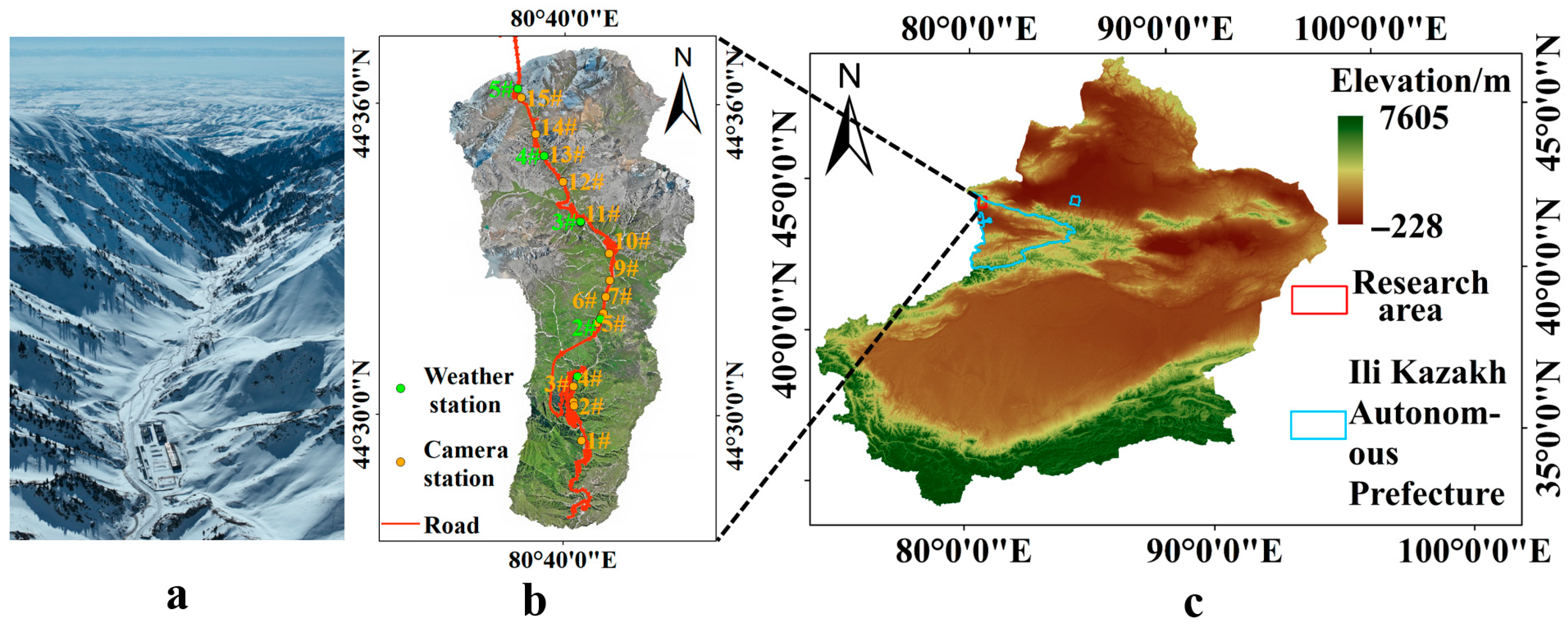

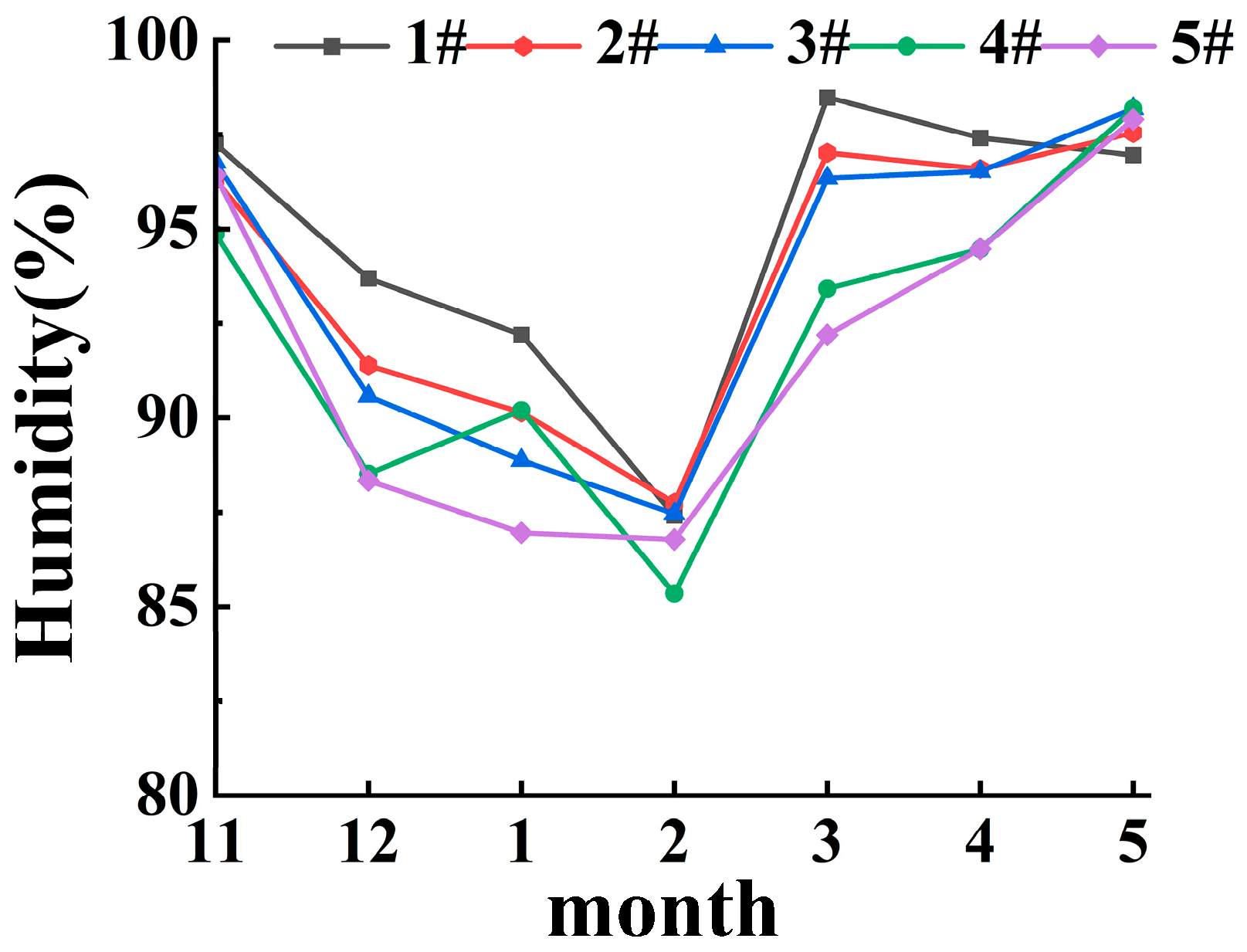

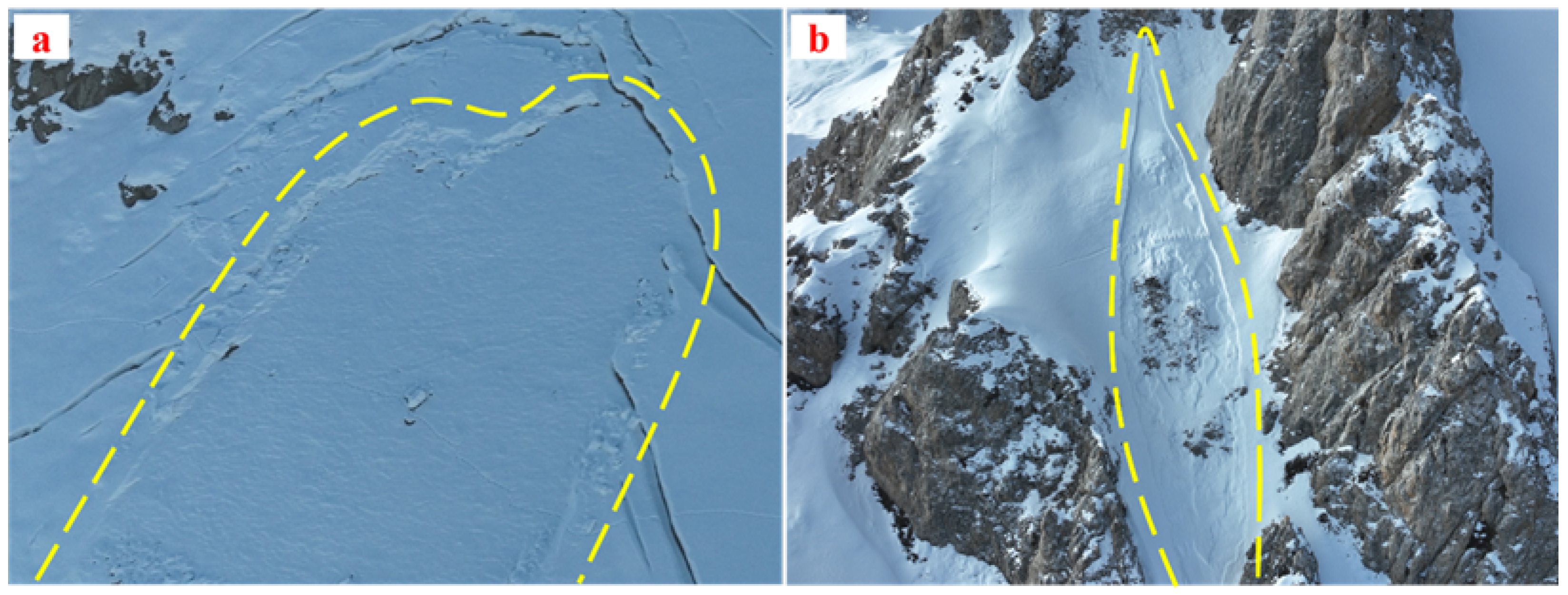
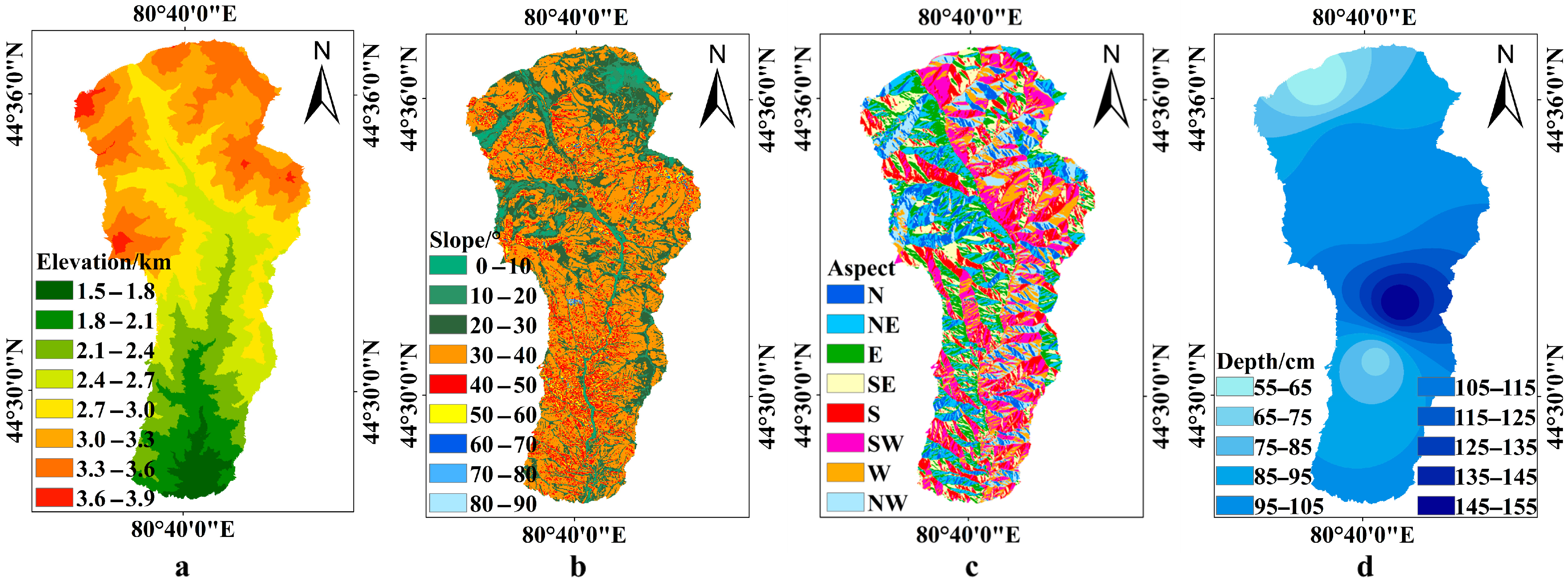

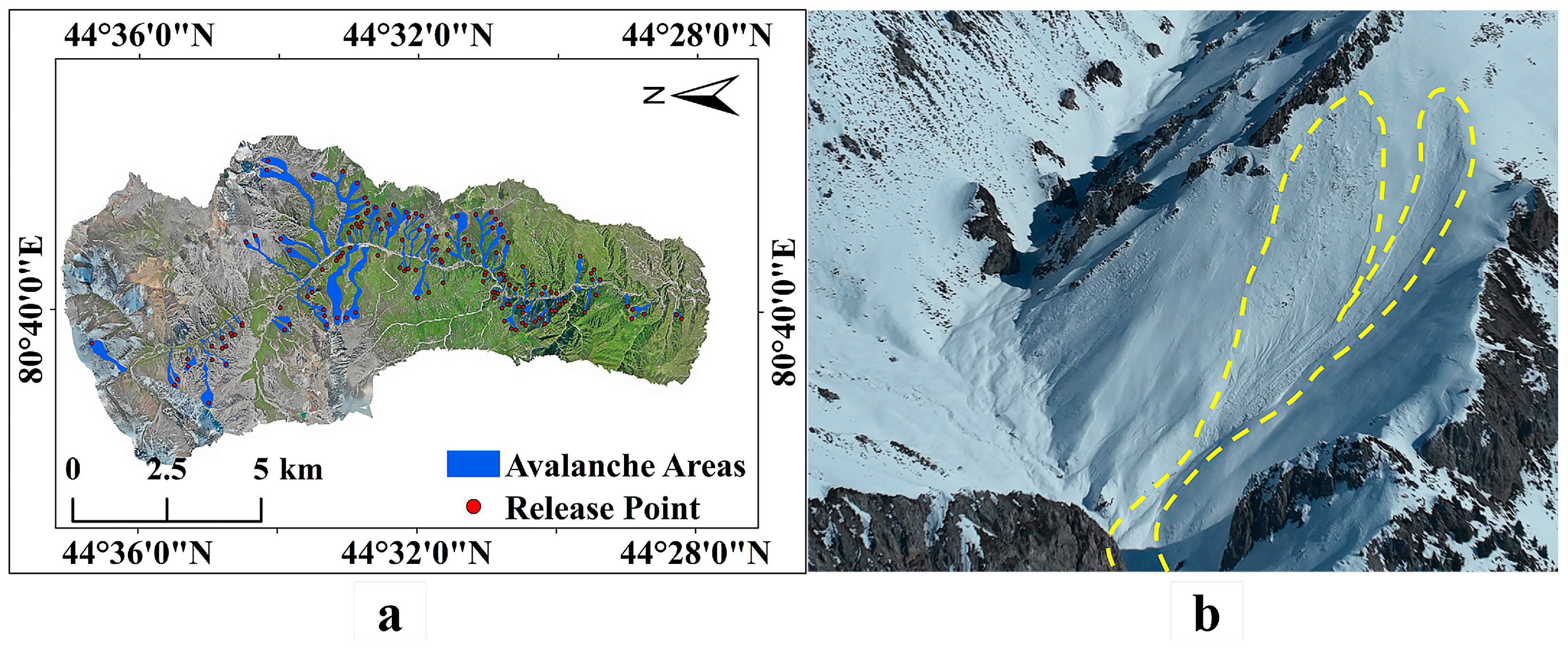
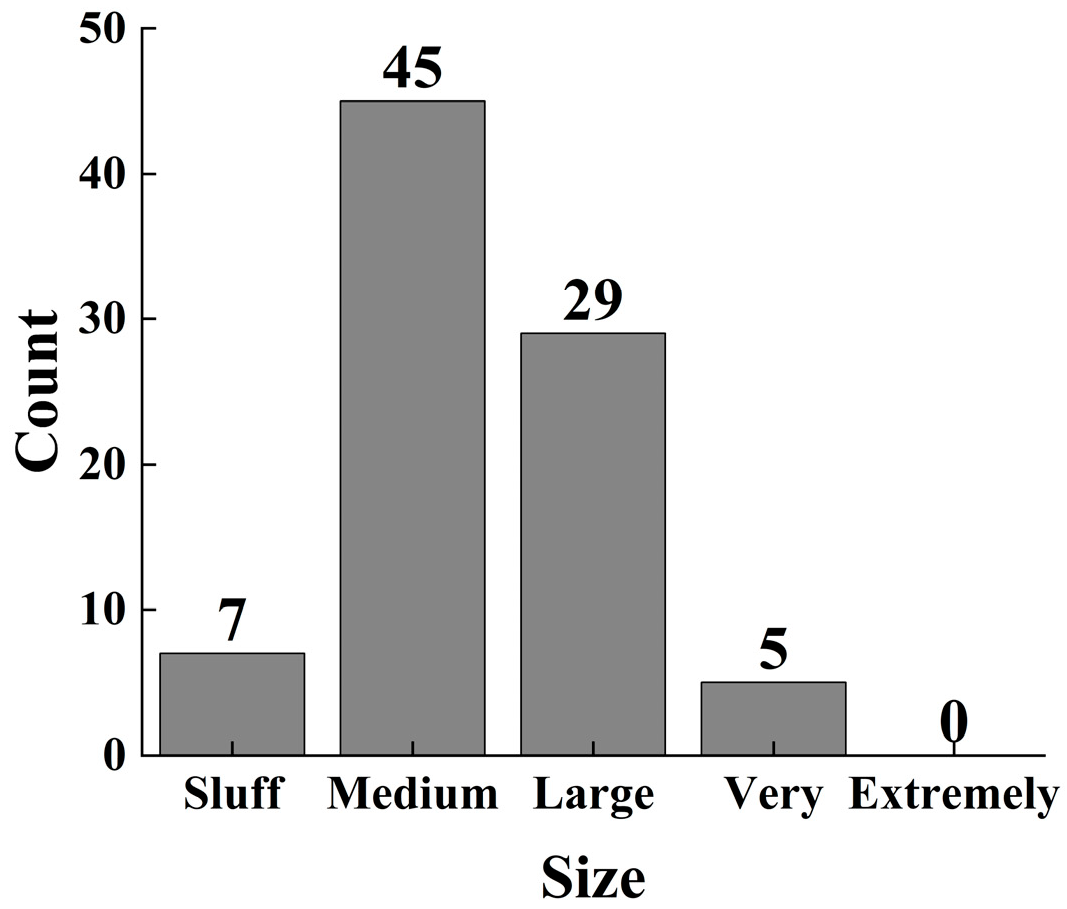
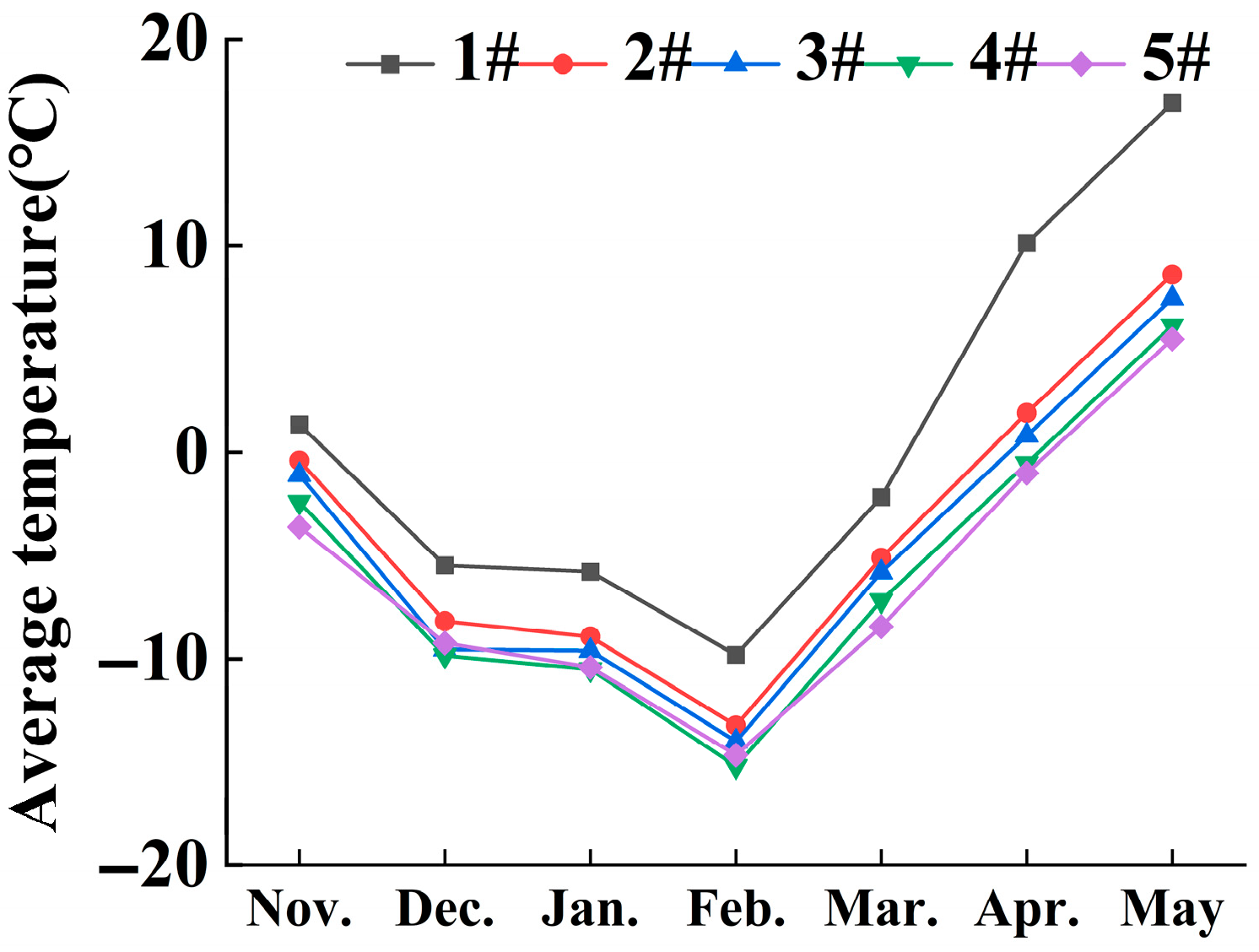
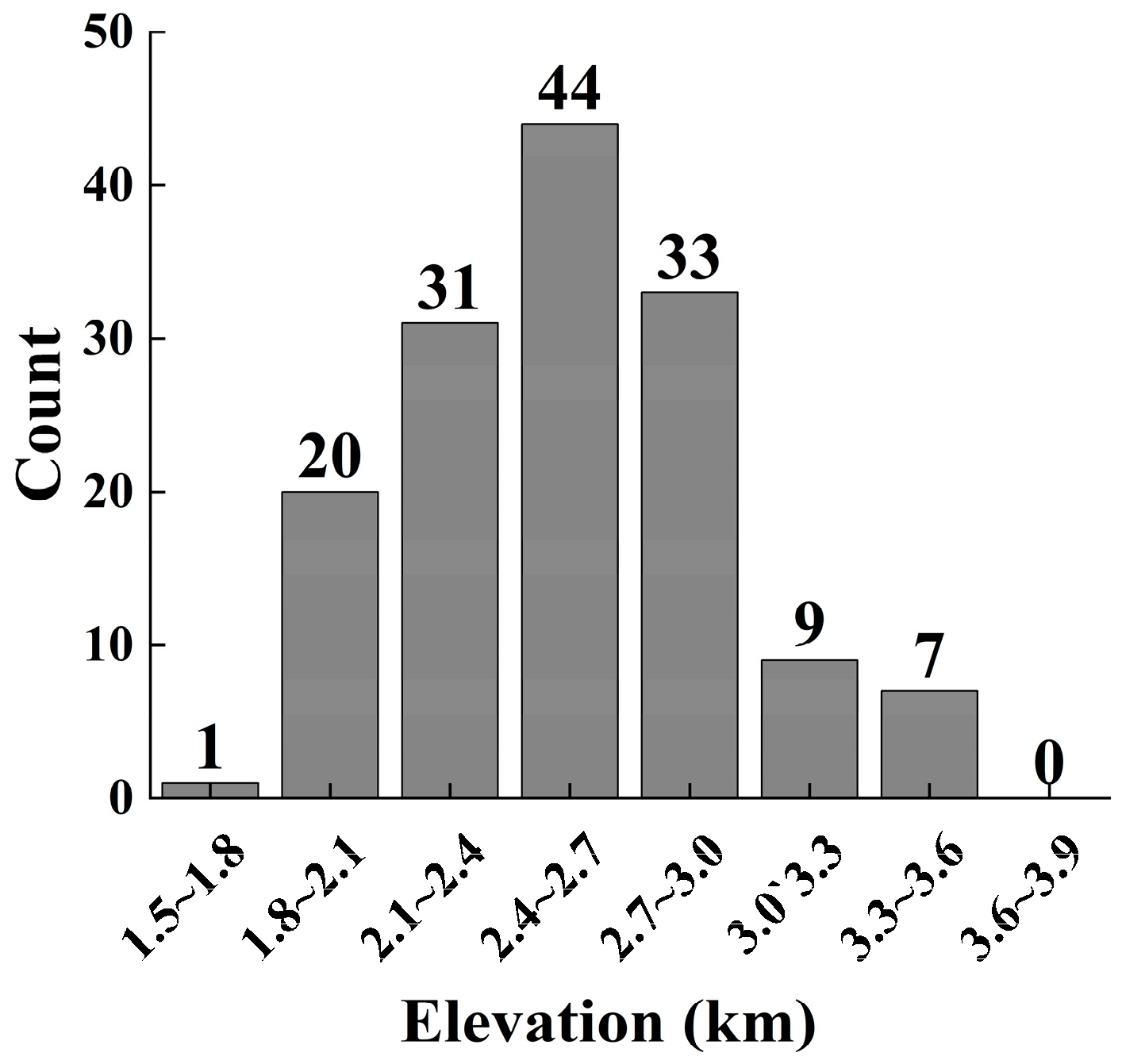




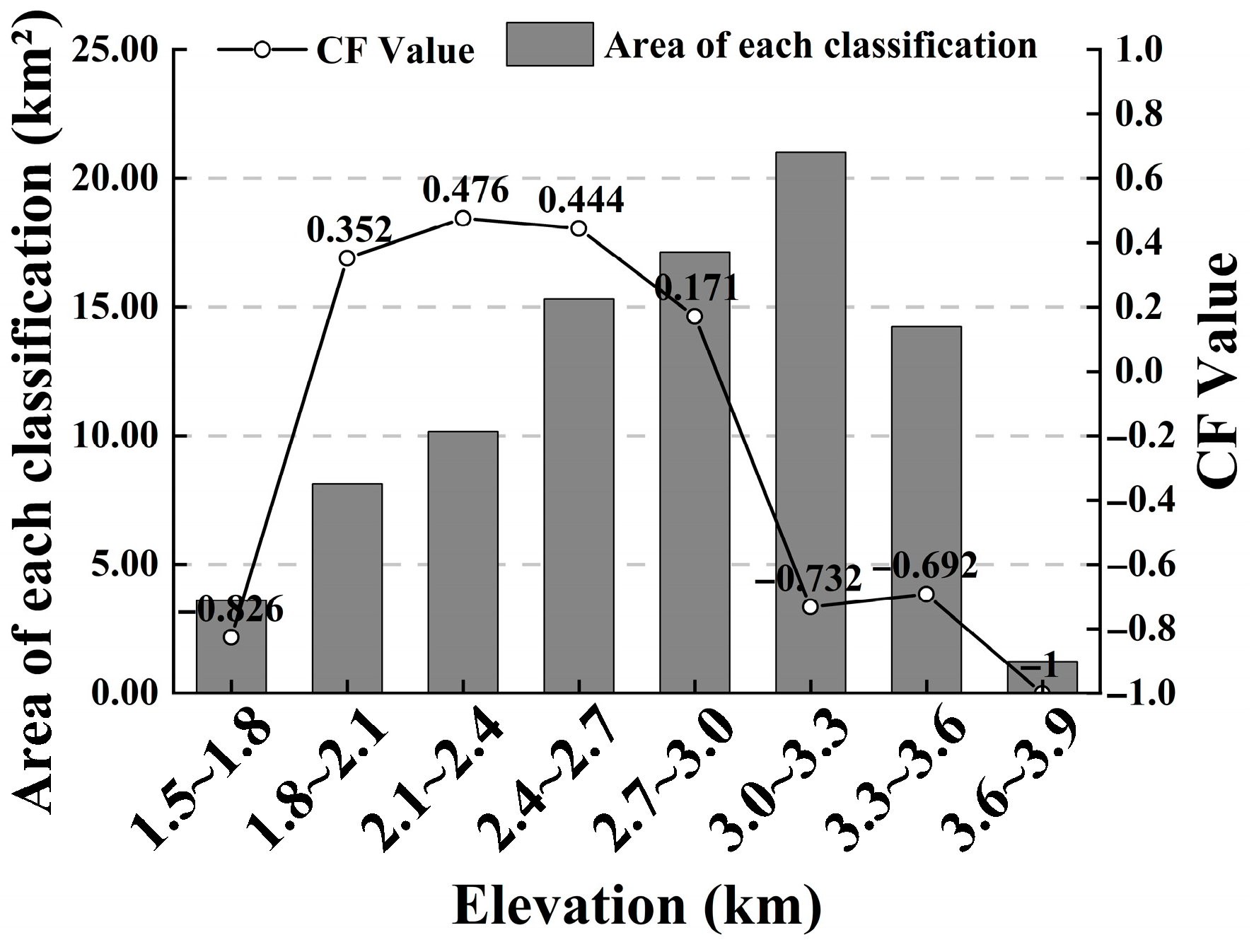
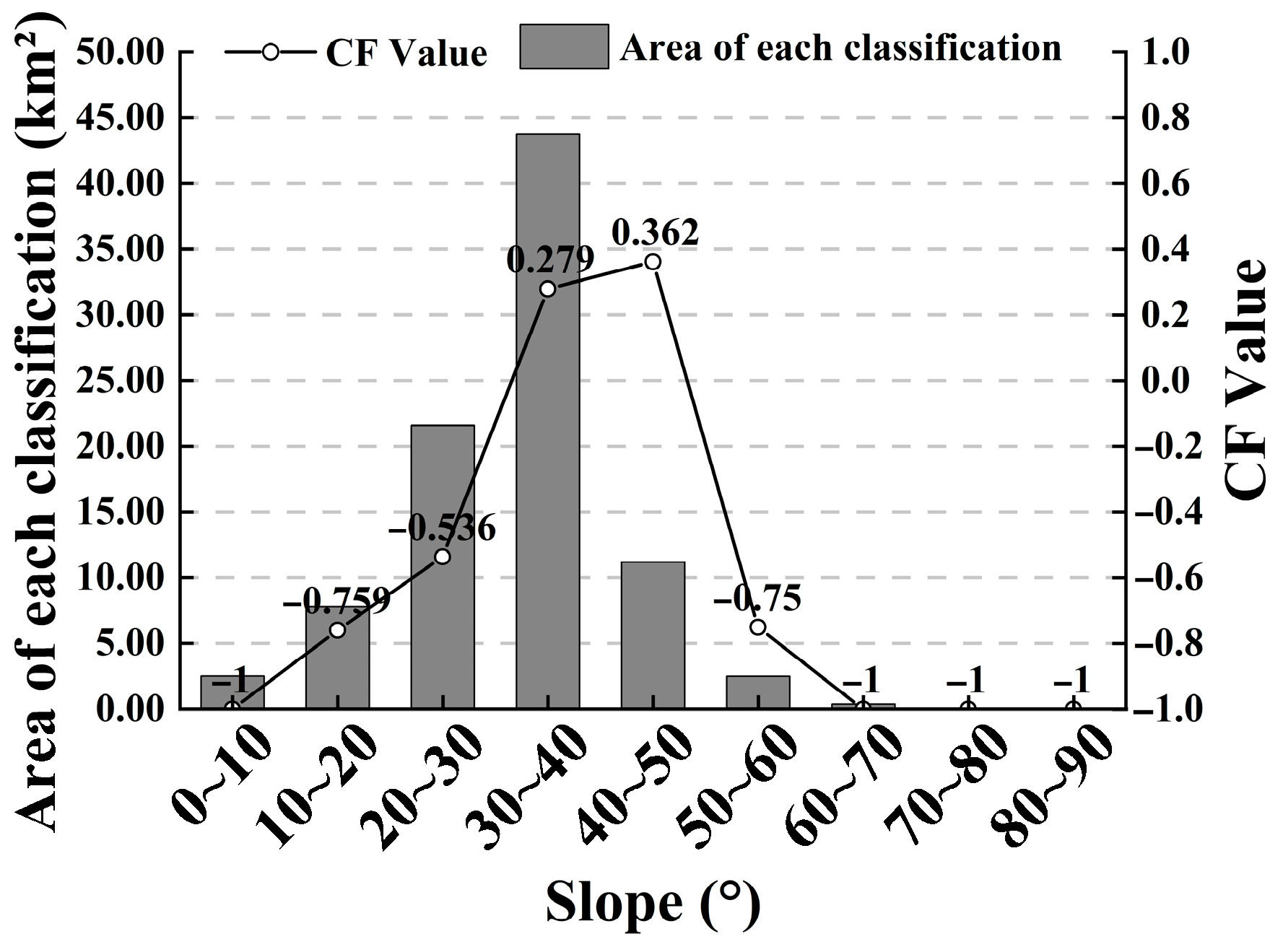
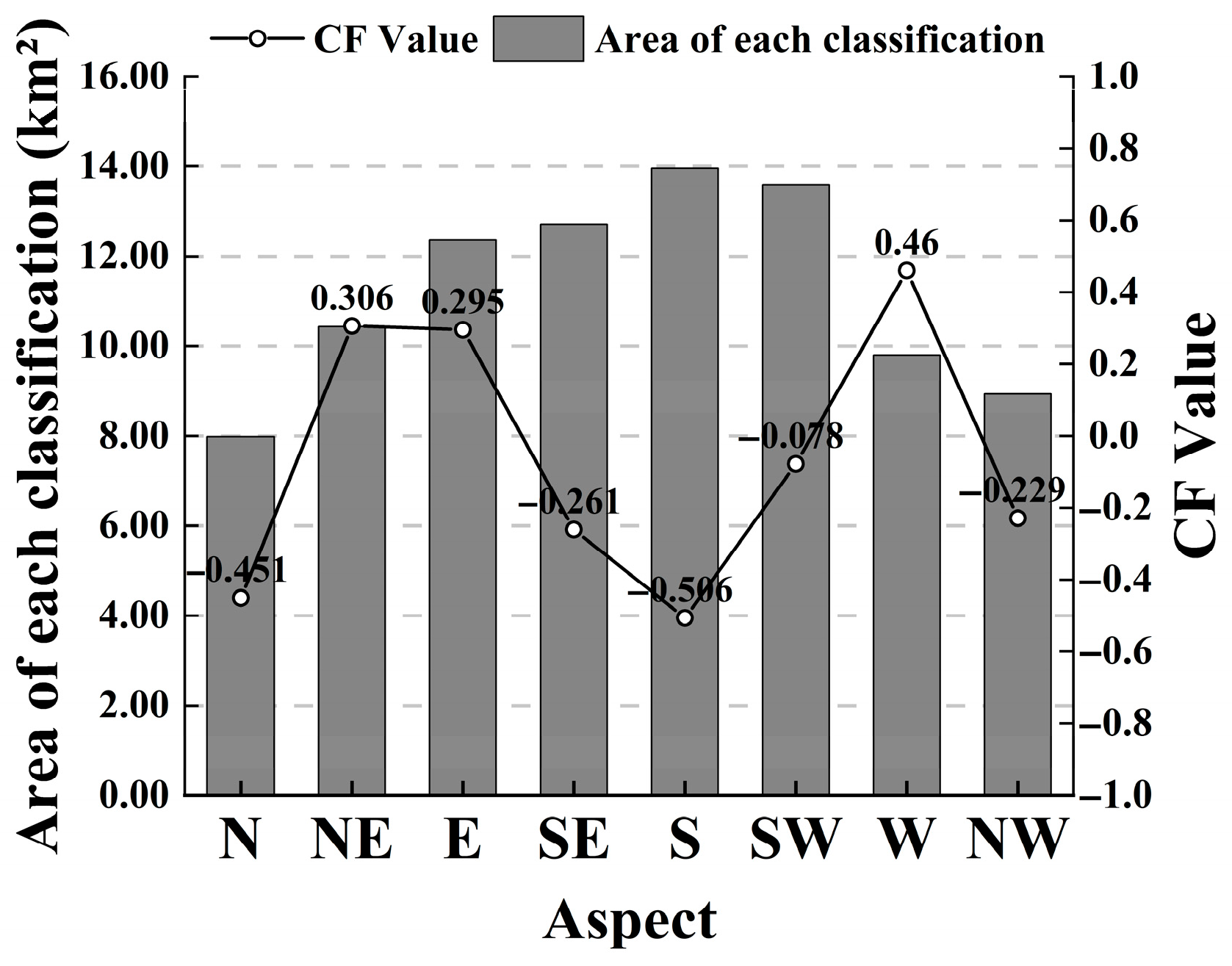
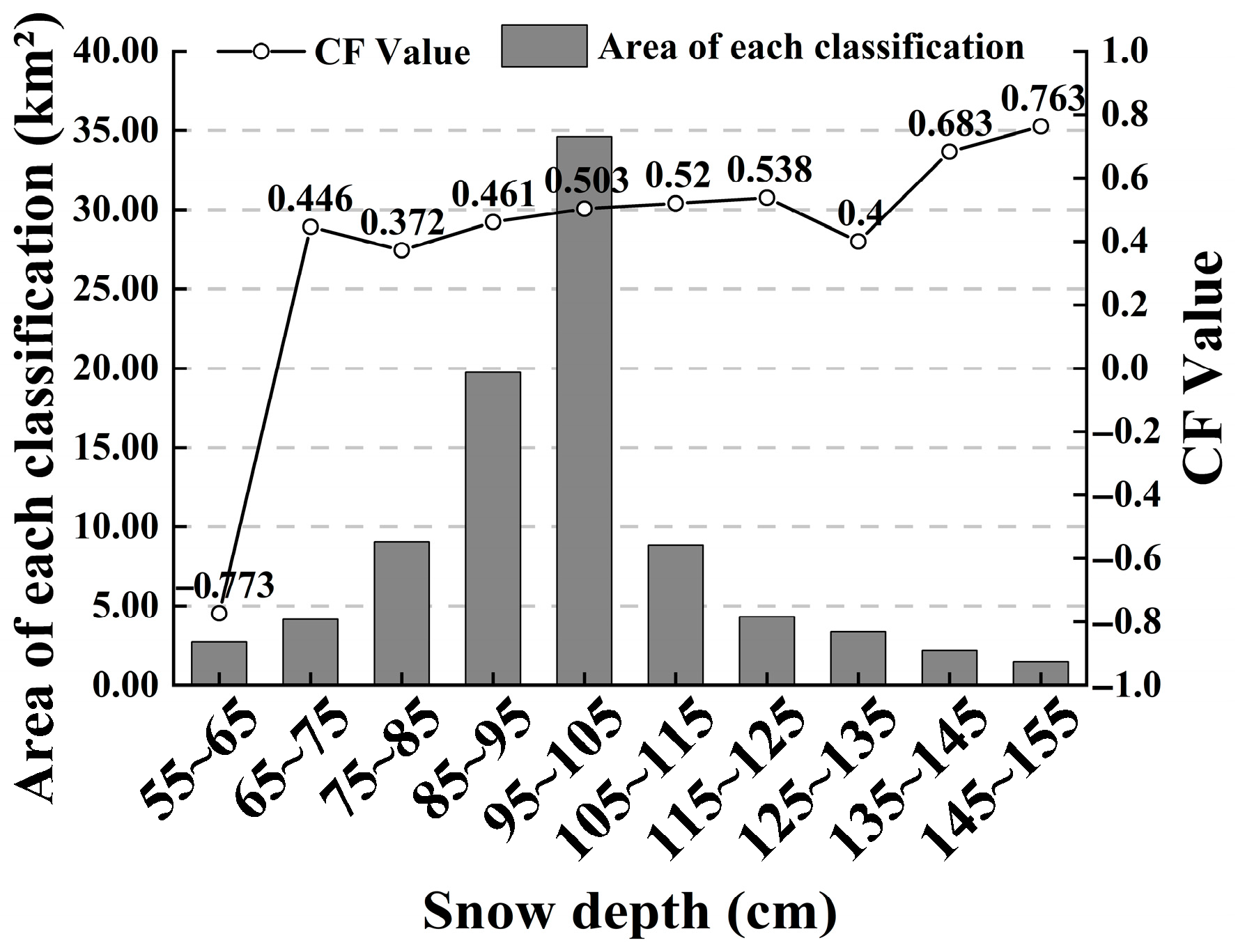
| Category | Count | Proportion |
|---|---|---|
| Chute-confined avalanches | 23 | 26.74% |
| Unconfined slope avalanches | 63 | 73.26% |
| Monitoring Parameters | Instrument/Sensor Model | Main Technical Indicators | Data Intervals | Equipment Manufacturer | Production Address |
|---|---|---|---|---|---|
| Video surveillance cameras | DS-2SK8C144MH-D/SP/GLT/DG | Focal length range: Panoramic 4 mm; detail 6.0~150 mm | 30~60 min | Hangzhou Hikvision Digital Technology Co., Ltd. | Hangzhou, China |
| Temperature and humidity | HMP155 Air temperature and humidity sensor | Range: 0~100% (RH); −80~+60 °C | 10 min | Beijing Truwel Instruments Inc. | Xi’an, China |
| Air pressure | PTB110 Air pressure sensor | Range: 500~1100 hPa; Accuracy: ±1.0 hPa | 10 min | Beijing Truwel Instruments Inc. | Xi’an, China |
| Wind speed | W10 Wind speed sensor | Range: 0~60 m/s; Starting wind speed: 0.17 m/s | 10 min | Beijing Truwel Instruments Inc. | Xi’an, China |
| Wind direction | W20 Wind direction sensor | Range: 0~360°; Accuracy: 0.088° | 10 min | Beijing Truwel Instruments Inc. | Xi’an, China |
| Snow depth | SnowVUE10 Digital snow depth sensor | Accuracy: ±1 cm; Resolution: 0.25 mm | 10 min | Beijing Truwel Instruments Inc. | Xi’an, China |
| Pilot Projects | Direct Shear Tests | Cutting Ring Sampler Density Measurements | Liquid Water Content Determination | Temperature Gradient Profiling | Crystal Morphology Photography | Extended Column Tests |
|---|---|---|---|---|---|---|
| Parameter | Shearing strength; Cohesion; Internal friction angle | Density | Moisture content | Snow temperature | Crystal morphology | Weak layer position |
| Average Snow Density (g/cm3) | Cohesion (g/cm2) | Frictional Coefficients | Shear Strength (gf/cm2) | Turbulent Friction Coefficients (m2/s) |
|---|---|---|---|---|
| 3.0~3.4 | 2.3~3.7 | 0.3~0.35 | 3.0~5.12 | 1000–3500 |
| Avalanche Magnitude | Topography | Elevation/m | Temporal Recurrence Intervals/Years | μ | ξ |
|---|---|---|---|---|---|
| Medium (25~60,000 m3) | chute-confined avalanches | >1500 | 10 | 0.35 | 1350 |
| Unconfined slope avalanches | >1500 | 10 | 0.2 | 3250 |
| Avalanche Magnitude | SLUFF | Medium | Large | Very | Extremely |
|---|---|---|---|---|---|
| Volume (m3) | 1~102 | 102~103 | 103~104 | 104~105 | >105 |
| Potential damage | Unlikely to bury a person, except in unfavorable runout zones. In extreme terrain there is a danger of falling. | Can bury, injure, or kill people. Many avalanches that kill people are classified as ‘medium’. | Can bury and destroy cars, damage trucks, destroy small buildings and break a few trees. Many avalanches that kill people are classified as ‘large’. | Can bury and destroy trucks and trains Can destroy fairly large buildings and small areas of forest. Very large avalanches can occur at danger level 3 and are typical of danger levels 4 and 5. | Can devastate the landscape and has catastrophic destructive potential. Typical for danger level 5 |
| Month | November | December | January | February | March | April | |
|---|---|---|---|---|---|---|---|
| Count | Dry snow avalanche | 0 | 4 | 9 | 10 | 3 | 2 |
| Wet snow avalanche | 1 | 11 | 9 | 55 | 82 | 16 | |
| Total | 1 | 15 | 18 | 65 | 85 | 18 | |
| Time | 10 | 11 | 12 | 13 | 14 | 15 | 16 | 17 | 18 | 19 | 20 | 21 | 22 | |
|---|---|---|---|---|---|---|---|---|---|---|---|---|---|---|
| Count | dry snow avalanche | 1 | 2 | 18 | 15 | 14 | 21 | 26 | 33 | 21 | 12 | 7 | 3 | 1 |
| wet snow avalanche | 2 | 2 | 2 | 3 | 2 | 3 | 3 | 2 | 2 | 2 | 1 | 2 | 2 | |
| total | 3 | 4 | 20 | 18 | 16 | 24 | 29 | 35 | 23 | 14 | 8 | 5 | 3 | |
| Avalanche Type | Fracture Depth (cm) | Average Density (g/cm3) | μ | ξ | Volume (m3) |
|---|---|---|---|---|---|
| Full-depth wet snow avalanche | 45 | 3.2 | 3250 | 0.20 | 205.646 |
| Avalanche Type | Fracture Depth (cm) | Average Density (g/cm3) | μ | ξ | Volume (m3) |
|---|---|---|---|---|---|
| Full-depth wet snow avalanche | 76 | 3.2 | 1350 | 0.35 | 205.646 |
Disclaimer/Publisher’s Note: The statements, opinions and data contained in all publications are solely those of the individual author(s) and contributor(s) and not of MDPI and/or the editor(s). MDPI and/or the editor(s) disclaim responsibility for any injury to people or property resulting from any ideas, methods, instructions or products referred to in the content. |
© 2025 by the authors. Licensee MDPI, Basel, Switzerland. This article is an open access article distributed under the terms and conditions of the Creative Commons Attribution (CC BY) license (https://creativecommons.org/licenses/by/4.0/).
Share and Cite
Wang, X.; Liu, J.; Guo, Q.; Wang, B.; Yang, Z.; Cheng, Q.; Xie, H. Avalanche Hazard Dynamics and Causal Analysis Along China’s G219 Corridor: A Case Study of the Wenquan–Khorgas Section. Atmosphere 2025, 16, 817. https://doi.org/10.3390/atmos16070817
Wang X, Liu J, Guo Q, Wang B, Yang Z, Cheng Q, Xie H. Avalanche Hazard Dynamics and Causal Analysis Along China’s G219 Corridor: A Case Study of the Wenquan–Khorgas Section. Atmosphere. 2025; 16(7):817. https://doi.org/10.3390/atmos16070817
Chicago/Turabian StyleWang, Xuekai, Jie Liu, Qiang Guo, Bin Wang, Zhiwei Yang, Qiulian Cheng, and Haiwei Xie. 2025. "Avalanche Hazard Dynamics and Causal Analysis Along China’s G219 Corridor: A Case Study of the Wenquan–Khorgas Section" Atmosphere 16, no. 7: 817. https://doi.org/10.3390/atmos16070817
APA StyleWang, X., Liu, J., Guo, Q., Wang, B., Yang, Z., Cheng, Q., & Xie, H. (2025). Avalanche Hazard Dynamics and Causal Analysis Along China’s G219 Corridor: A Case Study of the Wenquan–Khorgas Section. Atmosphere, 16(7), 817. https://doi.org/10.3390/atmos16070817






